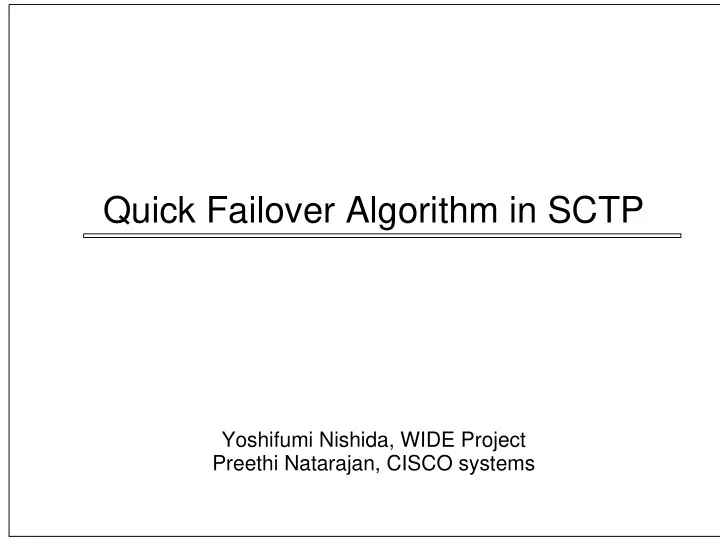

Quick Failover Algorithm in SCTP Yoshifumi Nishida, WIDE Project Preethi Natarajan, CISCO systems
Motivations Multihoming is a major feature of SCTP SCTP can migrate to secondary paths when primary path becomes unavailable But, SCTP needs 30-60 secs to failover in standard settings Describing remedies for this issue makes SCTP more useful and attractive
Issues in SCTP Failover Path.Max.Retrans is recommended to be 5 in standard SCTP needs 6 consecutive timeouts before failover RTO is doubled on each timeout Only retransmitted packets can reach the receiver during failover process RTO RTO RTO RTO A Data1 Data2 Data3 Data3 Data1 Data2 Data4 Data4 B1 (primary) ACK1 ACK2 ACK3 ACK4 (secondary) B2 A is sending data to B and B has two address B1, B2. when B1 becomes unavailable, SCTP keep using B1 until 6 timeouts
An Example for SCTP Failover Simulation result using ns-2.34 1400 PMR=5 1200 Received Packet (TSN) 1000 800 600 400 200 0 10 20 30 40 50 60 70 80 90 100 Simulation Time (sec) A is sending data to B and B has two address B1, B2 (B1 is primary) when primary becomes unavailable at 20 sec, it takes 60 secs to restart data transmission. (Path.Max.Retrans = 5)
Possible Solution (1) Adjust RTO related parameters The more RTO is small, the more SCTP can failover quickly Using smaller value for RTO.max Using smaller RTO.initial or RTO.min will also be effective Pros Simple, no need to modify kernel Cons Need to have enough knowledge about path Otherwise, it can cause adverse effects
Possible Solution (2) Reduce Path.Max.Retrans If Path.Max.Retrans = 0, SCTP switches to secondary on a single timeout Pros Simple, no need to modify kernel Cons A small violation of RFC (recommended PMR is 5) Need to consider Spurious failover Need to consider Asoc.Max.Retrans
Spurious Failover Issue If PMR is small, minor congestion can trigger failover Once failover happens, it will take long to back to the primary Recommended interval for heart-beat is 30 seconds Heart-beat Interval RTO A Data Keep Alive (primary) B1 ACK (secondary) B2 A is sending data to B and B has two address B1, B2. when a timeout happen on B1, SCTP switches to B2 and doesn’t go back to B1 until Heart-Beat is ACKed
Association.Max.Retrans Threshold for the total of error count for all pathes If error count exceed this threshold, association will be terminated It shouldn’t be larger than sum of PMR of all pathes Otherwise, even if all destination become inactive, endpoint still considers the peer reachable. But, if we reduce Assoc.Max.Retrans, association will be terminated with minor congestion
Adding New State in Path Management Difficulty in SCTP Path Management SCTP needs to satisfy contradictory requirements Respond network failure quickly Need to mark path inactive as soon as failure is detected Be robust against network congestions Need to be conservative to mark path inactive One solution: Introduce an intermediate state Timeout errcount > PMR errcount > AMR Potential Active Inactive Terminate Failure Association HB is acked
Possible Solution (3) Introduce Potential Failure (PF) State Path is possibly inactive, but not confirmed yet During PF state, Secondary path is used for data transmission If primary respond to heart-beat, go back to the primary Use new parameter PFHB.interval for heart-beat interval in PF state Allow to go back to the primary quickly Pros Use secondary path quickly Go back to primary quickly when primary is active No need to change PMR, AMR, HB.Interval Cons Need to update kernel (only sender side)
Summary Adjust RTO related parameters Simple. But not a common solution. Need to be used in limited situations Reduce Path.Max.Retrans Simple, But, need to care about Suprious timeout issue and Assoc.Max.Retrans issue Potential Failure State Need an extension to SCTP spec. however, Algorithm is simple and easy Only sender needs to be updated No need to change current protocol parameters
Do We Really Need This? Several choices Do nothing. 30-60 secs delay can be acceptable Leave developers and sysadmins to solve this Expect they will tune SCTP params appropriately Modify default parameters in the spec Some issues still remain Add PF extension to the spec More sophisticated solution CMT draft already includes PF We believe At least, we need to clarify the issue and document it People can know the issue and its solutions It would be better to have a standardized solution Otherwise, implementors will try various ways for this
Recommend
More recommend